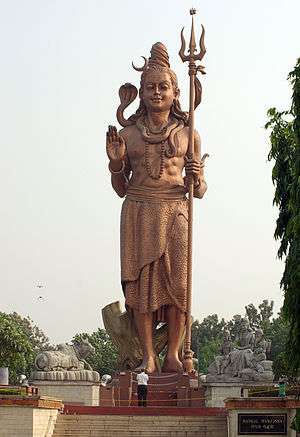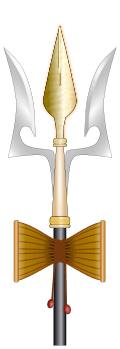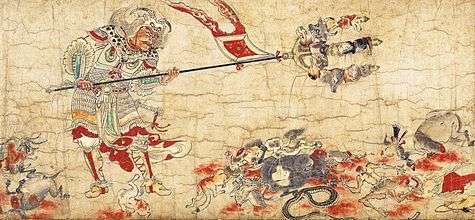Trishula
| Trishula | |
|---|---|
 Statue of Shiva holding a trishula in Rangpuri,Delhi | |
| Type | Trident |
| Place of origin | South Asia (Countries: India, Bhutan, Sri Lanka, Nepal , Afghanistan, Republic of Maldives, Pakistan (for Buddhists and Pakistani Hindus), Bangladesh). |
Trishula (Sanskrit: त्रिशूल, IAST: triśūla) is a trident, commonly used as the principal symbols in Hinduism and Buddhism.
In India and Thailand, the term also often refers to a short-handled weapon which may be mounted on a danda or staff. But unlike the Okinawan sai, the trishula is often bladed. In Malay and Indonesian, trisula usually refers specifically to a long-handled trident while the diminutive version is more commonly known as a chabang or tekpi.
Etymology
Trishul is also translated as Hindi: त्रिशूल triśūl, Kannada: ತ್ರಿಶೂಲ triśūla, Khmer: ត្រីសូល៍ (treiso), Malay: trisula, Marathi: त्रिशूळ triśūlla, Malayalam: തൃശൂലം tr̥iśūlaṁ, Telugu: త్రిశూలం trisoolam, Tamil: சூலாயுதம் (sulayutham), Thai: ตรีศูล (trīṣ̄ūl or tri), Sinhalese: ත්රිශූලය (triśūlaya) ..
Symbolism

The trishula symbolism is polyvalent and rich. It is wielded by the god Shiva and is said to have been used to sever the original head of Ganesha. Durga also holds a trishula, as one of her many weapons. The three points have various meanings and significance, and, common to Hindu religion, have many stories behind them. They are commonly said to represent various trinities—creation, maintenance and destruction; past, present and future; the three gunas. When looked upon as a weapon of Shiva, the trishula is said to destroy the three worlds: the physical world, the world of the forefathers (representing culture drawn from the past) and the world of the mind (representing the processes of sensing and acting). The three worlds are supposed to be destroyed by Shiva into a single non-dual plane of existence, that is bliss alone.
In the human body, the trishula also represents the place where the three main nadi, or energy channels (ida, pingala and shushmana) meet at the brow. Shushmana, the central one, continues upward to the 7th chakra, or energy center, while the other two end at the brow, there the 6th chakra is located. The trishula's central point represents Shushmana, and that is why it is longer than the other two, representing ida and pingala.
Other uses
- According to Shiva Puran, Shiva is swayambhu, self created, born of his volitions. He emerges as a direct incarnation of Sadashiv and has trishool from the very beginning.
- According to Vishnu puran, Vishwakarma created the trishula using the matter from sun and gave it to Shiva. When Suryadev married Sanjana, the daughter of Vishwakarma, his wife soon became unhappy with married life due to the unbearable heat of her husband Surya. She complained to Vishwakarma, who agreed to solve the problem. Her father came to an arrangement whereby Surya agreed to reduce his heat to accommodate Sanjana. Solar matter fell to the earth, reducing his heat by 1⁄8. That material was then used to make Trishul.
- Trishula can sometimes also designate the Buddhist symbol of the triratna.
- The goddess Durga holds a trishula among other weapons and attributes in her hands and amongst her accoutrement, having received celestial weapons from both Shiva and Vishnu.
- In Nepal, the trishula is the election symbol of the Communist Party of Nepal (United Marxist).[1]
- A similar word, Trishel, is the Romani word for 'cross'.
Gallery

_brought_as_offerings_to_Guna_Devi.%2C_near_Dharamsala%2C_Himachal_Pradesh.jpg) Trishula brought as offerings to Guna Devi, near Dharamsala, Himachal Pradesh.
Trishula brought as offerings to Guna Devi, near Dharamsala, Himachal Pradesh.
 Emblem of the Chakri Dynasty, the royal house of Thailand founded in 1782. The emblem of the dynasty consists of the trisula intertwined with the Sudarshana Chakra, another weapon, to create a Chakri.
Emblem of the Chakri Dynasty, the royal house of Thailand founded in 1782. The emblem of the dynasty consists of the trisula intertwined with the Sudarshana Chakra, another weapon, to create a Chakri. The Hachibushū Sendan Kendatsuba (or Candana Gandharva) is pictured killing several villains with his trishula in the collection of five paintings Extermination of Evil.
The Hachibushū Sendan Kendatsuba (or Candana Gandharva) is pictured killing several villains with his trishula in the collection of five paintings Extermination of Evil.
See also
- Trident
- Tekpi
- Sai (weapon)
- Kaumodaki - the armour used by Vishnu
References
- ↑ पार्टीको सूची — Election Commission of Nepal Archived 2013-11-02 at the Wayback Machine.
- ↑ Wat Arun The trident of Shiv extends from the top of each tower. Archived 2007-06-28 at the Wayback Machine.
External links
